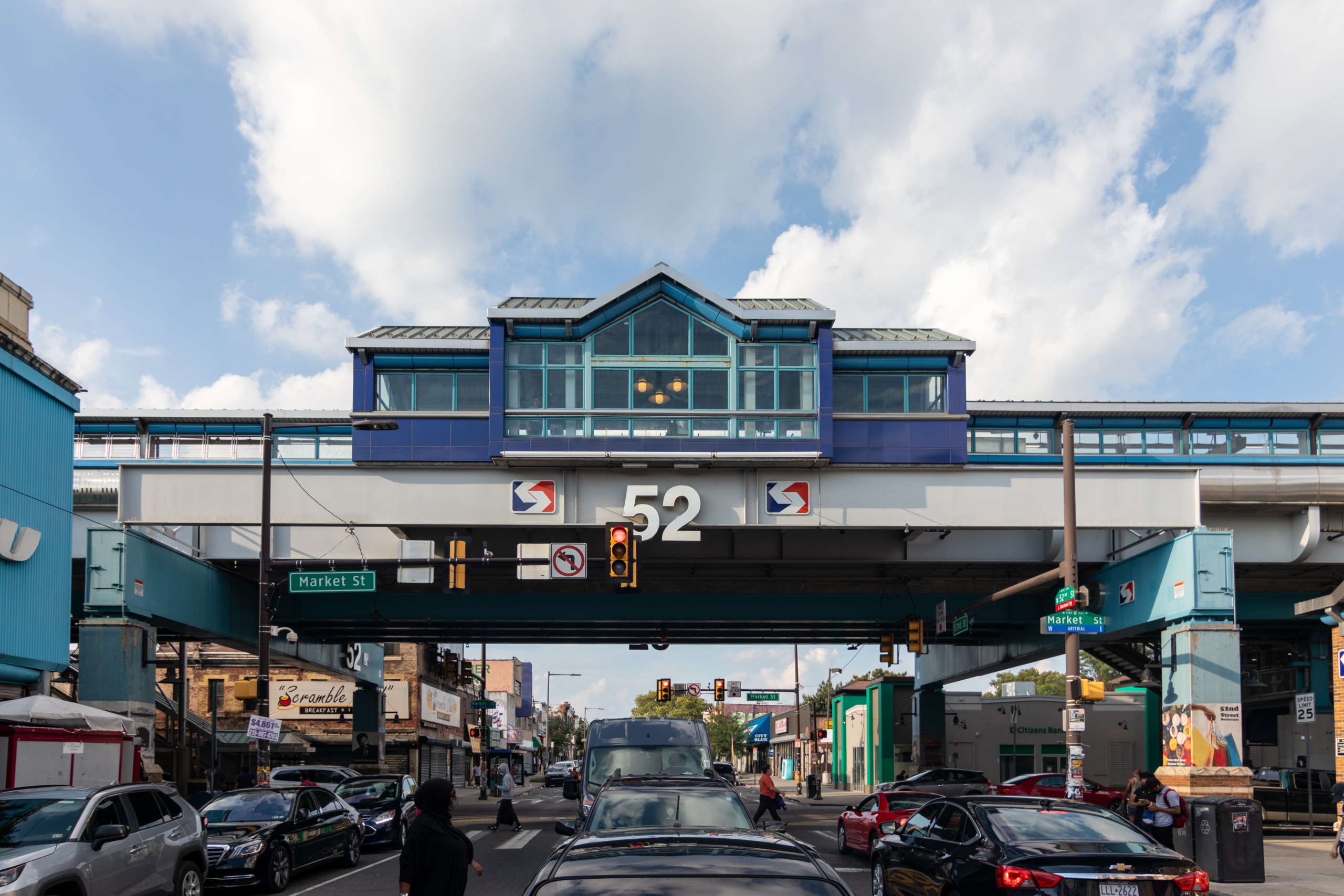
photographed by Tezarah Wilkins for WURD Radio
By Madhusmita Bora
George Floyd’s high-profile police killing and the ensuing public discourse on anti-Black racism, through protests on city streets and on editorial pages in newspapers across the U.S., compelled the biggest financial institutions in the country to take notice and have their own reckoning.
“We can do more and do better to break down systems that have propagated racism and widespread economic inequality, especially for Black and Latinx people,” said JPMorgan Chase CEO Jamie Dimon in a statement last year. “It’s long past time that society addresses racial inequities in a more tangible, meaningful way.”
The company announced a $30 billion commitment to advancing racial equality and economic opportunity for people and communities of color over four years.
“While this work had already been underway, we wanted to accelerate this effort in light of the tragic killings as well as the disproportionate impact of coronavirus on people of color,” Vanessa Cook, Senior Vice President of Media Relations at Bank of America, said in a written statement.
Others have made similar pledges. PNC promised $1 billion to social justice and economic empowerment of Black communities. Wells Fargo promised a $1 billion commitment to advancing racial equality and economic opportunity for people and communities of color.
“I believe that true liberation is the North Star for everyone,” said Paralee Knight, Vice President of Social Impact & Sustainability at Wells Fargo. “But we still have work to do in the space of equity right now, and we intend to continue to strive to make valiant progress in that space.”
“It’s long past time that society addresses racial inequities in a more tangible, meaningful way.” Jamie Dimon, CEO, JPMorgan Chase
While the pledges are very generous, they may not be all altruistic and their impact is still unclear, experts say. Philanthropic giving translates into tax breaks for corporate America, and they are not required to disclose intricate details.
“The demand for social justice created new tax legislation last year that allowed corporations to increase their charitable giving,” said Dr. Wayne W. Williams, Assistant Professor of Accounting at Temple University. “That is mutually beneficial to corporate community engagement and organizations addressing social inequality within the Black community.”
“The problem that I have is that the money hasn’t reached our communities,” said Jamie Lee Storms Jr., owner of Lee Jr. Entertainment, a Philadelphia event management company. “That’s a huge concern of mine. If they are giving to people, where is it going? How is it being allocated? Who is using the money?”
Storms Jr., who also works a full time job, received $1,800 in a Payment Protection Program loan. But, his business which relies on live events has struggled because of the pandemic.
Banks have been announcing the commitments on their websites and through the news media, but it’s unclear the tangible impact the funds will have on communities of color, including eligibility requirements for some of the programs.
“The problem that I have is that the money hasn’t reached our communities,” Jamie Lee Storms Jr., Owner, Lee Jr. Entertainment
“Anyone could say anything about anything, what does that mean? How can we go back and check who is receiving the money and what is the impact of the dollars,” said Jeannine Cook, owner of Harriett’s Bookshop in Philadelphia. “All these promises are not transparent or measurable.”
Cook’s store was open for six weeks when Covid struck and forced a shutdown. She started Harriett’s with her savings because when she approached banks, she was told that she didn’t qualify for a loan until she was in business for two years.
When the pandemic hit, she struggled. Then George Floyd happened.
“There was a frenzy all across the nation about how there was this magic money falling out of the sky,” she said about the financial pledges for racial justice. “But, not really.”
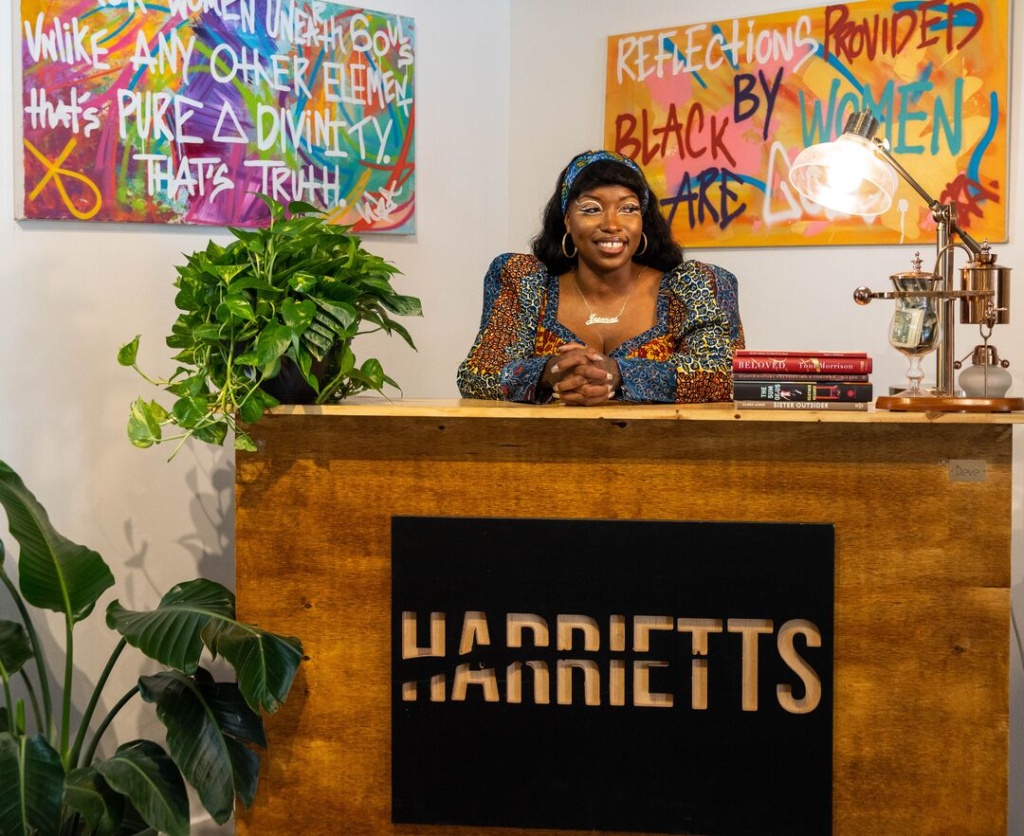
Jeannine Cook
Photo by Rob Rabena for Visit Phill
“It’s just a public statement and they are not always clear on how they intend to communicate
to the customer or the broader community,” said Tyrone McKinley Freeman, an associate professor of philanthropic studies and director of the undergraduate programs at the Indiana University Lilly Family School of Philanthropy. “That can be the tension with gifts. It’s one thing to announce and another to have an ongoing commitment to the public on what you are doing with the money, how you are doing it and what kind of impact it has.”
Tracking philanthropic giving can be difficult, McKinley Freeman said.
“Generally corporate giving data is that kind of a thing that relies on business entities to provide information on what they are doing with the money, how they are doing it and who it is impacting,” McKinley Freeman said. “We don’t know how this (pledges) plays out because we are still in the middle of it.”
Most of these pledges are a form of ‘diversity capital,’ said Professor Patricia Banks of Mount Holyoke College and author of the forthcoming book Black Culture, Inc: How Ethnic Community Support Pays for Corporate America.
“The fundamental role of corporations is that they will engage in actions that are not in conflict with profit making,” she said.
Banks, a sociologist, said that Black cultural patronage allows corporations to reap profits by signaling to their clients that they are invested in diversity, equity and inclusion. She said even though the impact is not great on the surface, it’s still a win because some of those funds support nonprofits, while corporations receive ethnic community support by cleaning up their track record on social justice.
“In this day and age, the racial image of corporations is very, very important because of the changing face of America,” she said. “Think about it as a form of impression management.”
According to the 2020 Census, the share of white population fell 6 percent compared to 2010. That’s the lowest on record. There are currently nearly 68 million of Gen Z (the generation born between 1997 and 2012) and a 2020 survey found that 69 percent of these young buyers want brands to be involved in the Black Lives Matter movement.
“The fundamental role of corporations is that they will engage in actions that are not in conflict with profit making,” Professor Patricia Banks, Mt. Holyoke College
Historically, banks have contributed to perpetuating economic inequality by redlining, charging people of color higher interest rates and fees and closing a disproportionate number of locations in minority neighborhoods.
A Federal Reserve survey showed that Black and Latino business owners were less than half as likely as their white counterparts to receive loan approvals. According to the 2021 Report on Firms Owned by People of Color, the disparity persisted even when the Black-owned, Latino-owned, and white-owned firms were all categorized as presenting a low credit risk. Black, Indigenous and other people of color (BIPOC) owned businesses tend to have weaker banking relationships, experience worse outcomes on credit applications and are more reliant on personal funds. This year, CtW Investment Group, which holds shares at Bank of America and JPMorgan Chase, urged the Board of Directors to oversee a racial equity audit analyzing the companies’ “adverse impacts on nonwhite stakeholders and communities of color.” Boards at both banks recommended the proposal be voted down stating that they are already working on racial equality and reporting on progress annually, according to SEC filings.
Damon Hopson, who launched Broomall-based Hopson Cleaning Services, Inc., in February 1999, couldn’t get a loan until he was “self sufficient” and his company financially successful, he said.
Hopson started with two employees, including himself, a few mopping buckets and vacuum cleaners and a roster of clients. Things were looking good until he needed capital to grow. Encouraged by white colleagues in the business, he decided to apply for a loan. The friends told Hopson how the money they borrowed from banks allowed them to scale up their businesses. Hopson was optimistic. He went to half a dozen banks including Bank of America, PNC, TD Bank, Bryn Mawr Trust and Wells Fargo. But he got the same response everywhere.
“No bank wanted to give me any capital without collateral,” he said. “I didn’t have bad credit, just no credit.”
When he finally was making $100,000 deposits into his Citizens Bank account, he requested a line of credit. Hopson was told that there was a lien on one of his accounts. He went to the Delaware County Courthouse and got a letter clarifying the confusion. But, he still got denied. And without an explanation, he said. He closed his account at the bank and took his business elsewhere.
“It’s like back in the slavery days when you had to guess how many jelly beans were in the jar to have a right to vote and they still wouldn’t let you,” he said. “Banks don’t want to help us, and they will look for ways not to fund us.”
Hopson’s company now makes $2 million in sales annually.
“I learned to save money, so if the bottom falls off, I can survive,” he said. “They (banks) want to help now when I don’t need it.”
Pamela Thornton, owner of Pound Cake Heaven, a veteran, who wanted to be her own boss, has a similar story.
“I am a homeowner. I had a good credit history but when I first started and went to Citizens Bank for a loan, I didn’t get it.”
With no bank support, Thornton hit a rough spot in her second year and her credit history took a dive.
“I had financial institutions coming after me,” she said. “It’s a miracle that the business survived.”
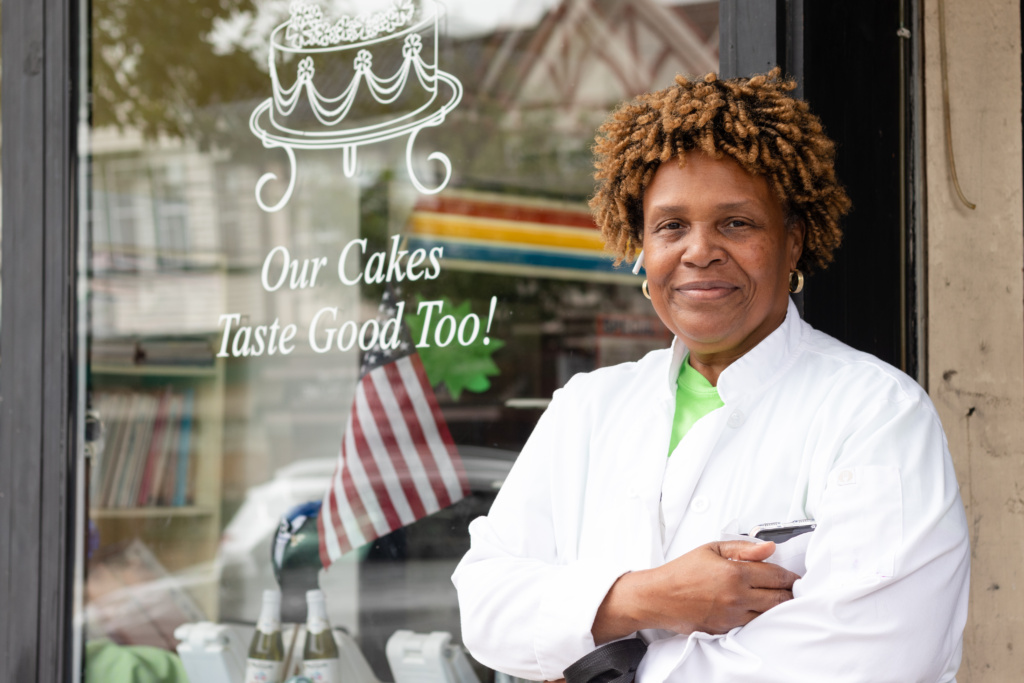
Pamela Thornton
photographed by Tezarah Wilkins for WURD Radio
Eventually she received a $15,000 micro-loan from the Women’s Opportunity Resource Center.
Black-owned businesses, such as those owned by Hopson and Thorton, have long struggled with loan approvals from mainstream banks.
The 1977 Community Reinvestment Act pushed financial institutions to serve low and moderate income neighborhoods. But, most struggling communities rarely have a bank location and financial institutions get away without investing in what is perceived as high risk communities. The screening process for approvals is stringent and the lack of resources and education in Black and Brown communities regarding bookkeeping and taxes compound the problem.
In 2018, the Treasury Department’s Office of the Comptroller found that Bank of America offered proportionately fewer home loans to minorities than to white applicants in Philadelphia. The bank shuttered many branches in majority-Black communities. It reduced the number of branches in majority Black neighborhoods by 29.1 percent, compared to the closure of 18.4 percent of branches in non-Black communities.
JPMorgan, which in October 2020 announced $30 billion over the next five years to advance racial equity and combat systemic racism, also has a conflicted history. The company faced multiple lawsuits related to discriminatory lending practices against communities of color, including a federal lawsuit related to mortgage discrimination. Like Bank of America, the company, too, has reduced the number of branches in Black communities by 22.8 percent between 2010 to 2018.
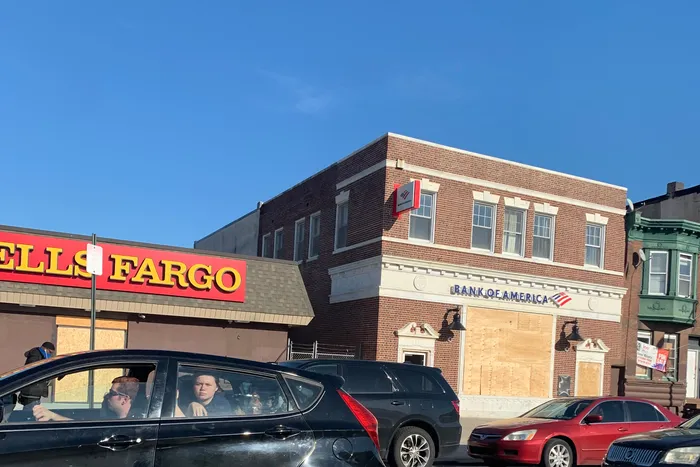
Photo by Joseph N DiStefano of the Philadelphia Inquirer
“It’s always difficult to find a bank or an ATM in a Black neighborhood,” said Williams of Temple University. “If there’s no lending institution within an area, there’s bound to be a decline in access to capital or investments. Where do you go to get a loan for your business or a mortgage for a home?”
Jim Burnett, Executive Director of VestedIn, a Community Development Financial Institution, said in Philadelphia, Black-owned small businesses struggle for yet another reason. The city historically has failed to support the small business community.
“If it’s (funds) not going to small businesses, it’s definitely not going to small Black and Brown businesses,” he said.
The lack of investment has widened the wealth gap for the city’s 43.6 percent Black population, the majority of whom have been deprived of creating generational wealth.
“There are louder voices that get funded,” he said. “The small business community doesn’t have an advocacy machine to promote their cause.”
Historical Perspective
In the U.S., persistent wealth gaps between BIPOC and white Americans stem from centuries of systemic racism and government policies that prevent Blacks and people of color from accumulating generational wealth, experts say. In 2019, the average Black Household had $142,330 wealth compared with $980,549 for the average white household. The total dollar gap between the wealth in white and Black households was $838,220.
“Money begets money and deprivation begets greater deprivation,” said Nicole Lee Ndumele, Vice President of Racial Equity and Justice at the Center for American Progress, an independent non-partisan policy institute. “People don’t understand that it is a cyclical problem and there is not one solution.”
Ndumele said the racial wealth gap was established during the 250 years of slavery and displacement of Indigenous people from their land. The cycle perpetuated through Jim Crow segregation and government policies and laws such as the GI Bill and New Deal, which enhanced wealth for whites and hindered Blacks from accessing economic opportunities.
The problem was exacerbated because of lack of investment in Black neighborhoods, schools, businesses and homeownership.
“Because Blacks were not able to build wealth, they were in struggling neighborhoods with poor schools, which made it hard to go to college or get a job to accumulate wealth,” Ndumele said. “Without real intervention this cycle will continue.”
Additional discrimation at jobs, in the criminal justice and healthcare systems helped to further widen the wealth gap.
A son of a single mom, Hopson worked as a bagger at a grocery store to help his mother with expenses. He said except for one brother, his other three siblings got caught up in drugs and alcohol.
“I could have easily been a statistic,” Hopson said.
A gym teacher, who became his mentor, noticed him at the grocery store and gave him a break at the cleaning company where he was a regional manager. His only condition was that Hopson kept up his grades at school. At age 17, Hopson lost his mother and was entirely on his own. He attended Pierce College, continued his cleaning job and moved into an efficiency apartment in West Philadelphia. When Hopson launched his business and banks turned him down on loans, he focused on what he already knew best. Being self reliant.
“It just put me in a position where I could only sink or swim,” he said.
It was only five years ago that he got his first line of credit. Hopson Cleaning Services now has more than three dozen corporate client accounts across the tri-state area.
Not everyone can beat the odds like Hopson or Thornton. Eight out of 10 Black-owned businesses fold within the first 18 months. Most small Black business owners don’t have accumulated wealth to support their entrepreneurial venture beyond a short period.
Pandemic Widens Gap
When Covid-19 struck, Black-owned businesses plummeted more than 40 percent between February and April 2020, according to a report by the House Committee on Small Business. That was the largest drop across any ethnic group.
“When the economy gets a cold, minority businesses get the flu,” said Ian Lawrence, Senior Director at The Enterprise Center.
The Payment Protection Program offered by the Small Business Administration offered little support. By the end of the first round, 70 percent of loans issued by the largest issuer, JPMorgan, went to majority white congressional districts, according to SEC reports. A study found that only 29 percent of Black business owners initially got PPP loan approvals compared to 60 percent of white applicants. Thornton of Pound Cake Heaven was among those who were turned away. So was Cook of Harriett’s Bookshop.
Most small Black business owners lack financial management and accounting practices, hindering their ability to access capital. Without quarterly and annual statements, tax documents and evidence of profit, applicants face rejections.
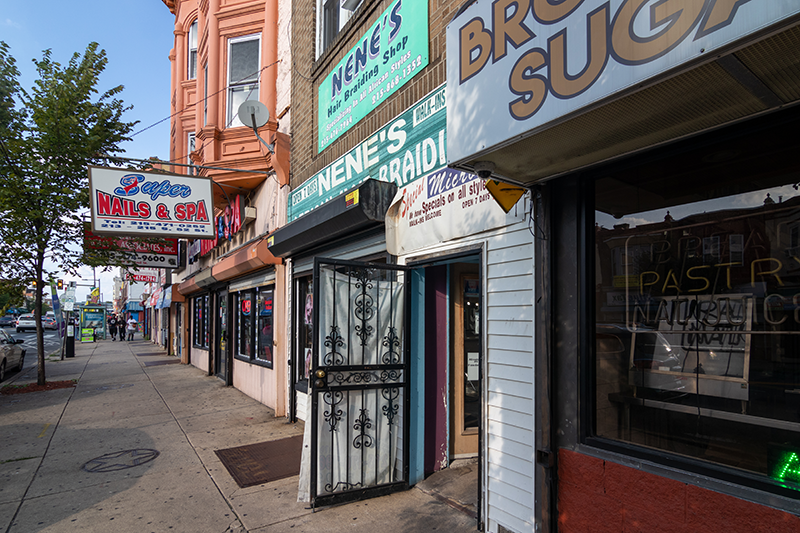
Photographed by Tezarah Wilkins for WURD Radio
The Enterprise Center and other Community Development Financial Institutions (CDFIs) worked with their clients coaching them on the necessary recordkeeping and paperwork, which helped the second round of applicants. Thornton, with the support of the Women’s Opportunities Resource Center, received funding in the second round, which was more accessible to minority owned businesses.
“Only when I got the check, I was able to exhale,” she said. She is now dreaming of adding another location.
Lynne Cutler, president of the WORC, said “65 percent of the businesses that received PPP funding through her organization were Black owned.”
“It is going to take additional time and resources for the businesses to recover, ” Cutler said. “ In general they had very little savings or working capital so their savings have been depleted.”
The Road Ahead
As Cutler pointed out, the pandemic recovery process has begun for some Black-owned businesses, but the path ahead is still uncertain for many who are struggling.
Last Spring, Wells Fargo announced $8.35 million in new funding for small business recovery efforts to Community First Fund, The Enterprise Center, Entrepreneur Works, The Reinvestment Fund and Women’s Opportunity Resource Center. Many of the projects are still in the gestation phase, bank officials said. Roughly 80 percent of that money is going toward BIPOC and women entrepreneurs through the different organizations, bank officials said.
Burnett of VestedIn said that much of the money announced by the big banks have yet to trickle down to the intended constituents. There is another problem. Even though there’s a strong desire now to make more funds available for Black communities, there is also a traditional investment mentality over return on investment, he said.
“This means they will create structures for investors to get returns and those structures have historical limitations and we will be defaulting to the norm,” he said. “They are not just doing that all out of benevolence.”
Williams of Temple University said there needs to be more alternatives to traditional banks such as CDFIs, which are more likely to provide access to capital to clients that may seem less creditworthy for a big bank.
For now, city business leaders are focusing on what is in their control. Kenneth Anderson, Vice President of Civic Affairs at The Chamber of Commerce for Greater Philadelphia said the Chamber is working with banks and CDFIs to help provide educational and technical assistance to small minority-owned businesses.
“If an organization or a business needs accounting services, we will source and identify and make connections so they are in a better position to get money from the bank,” Anderson said.
Hopson, who was able to qualify for a PPP loan, is not optimistic about seeing real changes anytime soon. He said there needs to be representation from communities of colors in boardrooms and decision-making bodies.
“We definitely need to have people who look like us, come from the same neighborhood and can relate to us to sit on advisory boards of financial institutions,” he said. “Compassion and empathy are needed in boardrooms for any real change to happen.”
Madhusmita Bora (she/her) is a writer, teacher and an award-winning multidisciplinary artist. She has previously worked for The Philadelphia Inquirer, Indianapolis Star and St. Petersburg Times (now Tampa Bay Times).
This story is part of a series called The Future of Work, which explores what work will look like as we move beyond the pandemic. It’s produced with funding from the William Penn Foundation and the Lenfest Institute for Journalism. WURD/Lively-Hood is one of more than 20 news organizations producing Broke in Philly, a collaborative reporting project on solutions to poverty and the city’s push towards economic mobility.

What the Banks Have Pledged
The social and political outrage last year following the killings of George Floyd, Breonna Taylor, Ahmaud Arbery and countless others accelerated the momentum for racial justice. The movement, along with awareness about the disproportionate impact of Covid-19 on Black and Brown communities, have made banks and financial institutions realize that they cannot be passive spectators in communities they serve. Here is a list of some publicly traded banks and a few pledges they have made toward their commitment to social justice.
Bank of America
- Announced a $1 billion commitment to advancing racial equality and economic opportunity for people and communities of color.
- In March, the bank announced a commitment of $1.25 billion over five years to support investments to address racial justice, advocacy and equality for people and communities of color.
- Since June 2020, Bank of America said it invested nearly $480 million to help create opportunity for people and communities of color. This includes $50 million in Community Development Financial Institutions (CDFIs) and Minority Depository Institutions Program (MDI) investments, $350 million in direct equity investments in minority entrepreneurs, businesses and funds, $25 million through signature jobs initiative, and more than $50 million in philanthropic funding (building on the $250 million in philanthropic funding that the company already provides).
- The company also said it provided more than $250 million in capital to CDFIs and MDIs to facilitate lending through the PPP, and $10 million in philanthropic grants to help fund the operations of CDFIs and MDIs.
Capital One
- In June 2020, the bank announced an ongoing commitment of $10 million to organizations advancing social justice causes for Black communities.
- Established an associate gift matching program and for a period matched dollar-for-dollar donations made by associates to Campaign Zero, the Equal Justice Initiative, National Urban League, Race Forward, Black Health Alliance (Canada) and Runnymede Trust (U.K.)
- In March 2020, the bank committed $50 million to help address communities impacted by the pandemic. The bank said it expedited resources through partner relief grants with a focus on supporting food and hunger relief, housing and shelter security, support to small business owners, and assistance for low-income individuals.
Citizens Financial Group
- In 2020, the bank gave $10 million in grants and charitable support for immediate and long term initiatives to support minority-owned small businesses, increasing awareness of racial disparities, and helping underserved communities through technology, education, and digital literacy initiatives. The bank also pledged an additional $500 million in incremental financing and capital for small businesses, housing and other development in predominantly minority communities.
JP Morgan Chase
In 2020, the bank committed $30 billion over the next five years to advance racial equity and combat systemic racism within the communities in which they work. Here’s how some of the money would be funnelled:
Housing:
- Originating 40,000 new home purchase loans for Black and Latinx households by committing $8 billion in mortgages to promote affordable housing and homeownership for underserved communities through new home purchase loans.
- The bank committed $4 billion in refinancing loans for Black and Latinx households to lower mortgage payments.
- Promised 100,000 affordable rental units through a $14 billion commitment in new loans, equity investments and other efforts.
Business:
- Grow Black and Latinx-owned businesses by allocating $2 billion and providing 15,000 additional loans to small businesses in majority-Black and Latinx communities.
- Launched a program providing small businesses with 1:1 coaching and mentorship to help grow their businesses.
- Pledged $750 million for Black and Latinx suppliers.
- Committed to accelerating a digital lending product to support the needs of small Black- and Latinx-owned businesses seeking quick access to capital.
- Accelerate investment in employees and build a more diverse and inclusive workforce by holding executives accountable for progress on diversity, equity and inclusion priorities.
- In collaboration with LISC and a network of CDFIs, JPMorgan Chase said it is joining other funders and supporting the expansion of the Entrepreneurs of Color Fund, currently operating in five U.S. cities, to a nationwide program providing low-cost loans and technical assistance to minority-owned small businesses.
Financial Health:
- Committed to helping one million people open new low-cost checking or savings accounts. To do this, the firm commits to hiring 150 new community managers, opening new Community Center branches in underserved communities and increasing marketing spend to reach more customers who are currently underserved, unbanked or underbanked. So far the bank said it has opened seven Community Centers across the country.
- As part of the firm’s market expansion initiative, Chase will continue to open 100 new branches in low-to-moderate income communities across the country, including in Chicago, Atlanta, Detroit, Oakland, and New Orleans, among others.
- The bank is investing $50 million in the form of capital and deposits in Black and Latinx-led Minority Depository Institutions (MDIs) and Community Development Financial Institutions (CDFIs). The bank said these investments will be based on responsible vetting of the capacity of the institutions and the benefit the capital or liquidity would provide to the local communities they serve. Chase has also committed to mentor and advise select MDIs and CDFIs to help them achieve future success.
PNC BANK
- In June 2020, PNC committed $1 billion to advance social justice and economic empowerment of Black Americans and low-and-moderate income communities. “We are making significant progress on this commitment, which will come to life through education, entrepreneurship and economic empowerment, and as of August 9, 2021, we have committed $270 million toward this pledge,” said Kristen Pillitteri, vice president, senior communications lead corporate responsibility.
- Pledged more than $50 million in charitable support work to help eliminate systemic racism and promote social justice, expand financial education and workforce development initiatives and enhance low-income neighborhood revitalization and affordable housing.
- With the acquisition of BBVA USA, PNC has announced a Community Benefits Plan through which the company will provide at least $88 billion in loans, investments and other financial support to benefit low- and moderate-income individuals and communities, people and communities of color, and other underserved individuals and communities over a four-year period beginning January 2022.
- PNC formed Empowerment & Inclusion Capital I, a Special Purpose Acquisition Company (SPAC) focused on acquiring a diverse-led business or a business focused on promoting an inclusive economy and society, said Kristen Pillitteri V.P., Senior Communications Lead for Corporate Responsibility. “This SPAC is unique in that all proceeds from our sponsor interest will be donated to the PNC Foundation to support our ongoing efforts to help end systemic racism and drive economic empowerment for Black Americans and low- and moderate-income communities,” Pillitteri said in an email. The bank also invested in Greenwood, a digital banking provider that is committed to advancing economic empowerment of minority and traditionally underserved communities and to promoting racial equity in financial services. “These efforts build upon our long-standing commitment to diversity and inclusion, which is embedded in the organization from the very top to the front lines,” Pillitteri said. “We have the most diverse board and executive committee in our company’s history.” Twenty five percent of the bank’s independent board directors are racially diverse, the company said.
- Offered $15 billion in loan modifications and funded small businesses with approximately $13 billion in Paycheck Protection Program loans.
- Invested $30 million into communities disproportionately impacted by the pandemic.
Wells Fargo Bank
- Is committing up to $1 billion in philanthropic capital to address the U.S. housing affordability crisis through 2025.
- Pledged to invest up to $50 million in African American Minority Depository Institutions to support economic growth in African American communities.
- Committed to donating all of the gross processing fees from funding Paycheck Protection Program loans made in 2020 by creating the Open for Business Fund, which provides support to struggling small businesses impacted by Covid-19. Of this approximately $420 million commitment, Wells Fargo donated $85 million in 2020 and will continue to donate these funds through 2022.
- The bank is providing capital and technical assistance for diverse small business owners in the U.S. as part of the Wells Fargo Diverse Community Capital Program, a $175 million program with Community Development Financial Institutions.
- Wells Fargo is also donating $175 million through the Wells Fargo Foundation to support economic recovery for communities and vulnerable populations affected by Covid-19.
- It is increasing access to and awareness of affordable products and digital banking solutions in unbanked communities—directly and through partner providers.
- The bank has committed to deepen existing relationships with Black-owned Minority Depository Institutions (MDIs) to support their work and expand their reach and ability to serve individuals in their communities.
- Wells Fargo said it is increasing funding and support to expand the Credit Builders Alliance (CBA) low-cost, credit-building consumer loan program allowing their lender members to increase the number of loans they make and increasing efforts to build awareness and outreach about low-cost, no overdraft fee accounts, such as Wells Fargo’s Bank On-certified Clear Access Banking account.
- The bank is broadening collaboration with the CFE Fund and local banks on coalitions to pilot new strategies and approaches that help overcome barriers to banking access in several markets with high concentrations of unbanked households. The program will be used to identify best practices that can be applied on a national scale.
- The bank said it is working closely with Fintechs that are deeply committed to help underserved communities, starting a collaboration to help the Fintech MoCaFi provide banking to unbanked individuals.
- In low or moderate income community census tracts, where Wells Fargo operates more than 25 percent of its branches, they are introducing a new program designed around the needs of the diverse communities.
- In designated branches, Wells Fargo will introduce redesigned spaces created to deliver one-on-one consultations, improve digital access and offer financial health seminars.
- The company plans to expand to 100 LMI neighborhood branches with a high concentration of unbanked individuals.
WSFS Bank
- In June 2020, WSFS made a $200,000 donation to four CDFIs: Chester County Chamber of Business & Industry/Chester County Community & Economic Development Corporation (Chester County, Pa.); Cooperative Business Assistance Corporation (Burlington and Camden Counties, N.J.); Entrepreneur Works Fund (Bucks, Delaware, Montgomery and Philadelphia Counties, Pa.); and True Access Capital (Delaware).
The money is intended as relief grants to help local small businesses impacted by the pandemic. One of the criteria for the organizations chosen was that a percentage of the grantees be woman owned or minority owned businesses, the bank said.
Source: SEC Filings, Equilar and Interviews

The ABCs of CDFIs and
Local Resources for Small Businesses
Are you a Philadelphia small business struggling to grow your network, find resources and technical assistance? Are you curious about how the bank pledges might support you?
Here’s a list of organizations, where you can find more information on loans, grants, professional development training and other resources for small businesses.
African American Chamber of Commerce
Regina A. Hairston, President & CEO
rhairston@aachamber.org
(215) 751-9501 ext. 104
Chamber of Commerce for Greater Philadelphia
Rob Wonderling, President & CEO
rwonderling@chamberphl.com
(215) 790-3666
Community First Fund
Daniel Betancourt, President & CEO
dbetancourt@communityfirstfund.org
(717) 869-5416
Enterprise Center Capital Corporation
Della Clark, President & CEO
info@theenterprisecenter.com
(215) 895-4000
Entrepreneur Works
Leslie Benoliel, President & CEO
lbenoliel@entre-works.org
(215) 545-3100 ext: 223
Fox School of Business, Small Business Development Center
Maura I. Shenker, Director
tuk40467@temple.edu
(215) 204-7282
Goldman Sachs 10,000 Small Businesses
Community College of Philadelphia
10KSB@ccp.edu
(267) 299-5806
Impact Loan Fund
Casey O’Donnell, CEO
info@impactservices.org
(215) 739-1600
North Philadelphia Financial Partnership
Reco Owens, Executive Director
rowens@npfp.org
(215) 232-0516
Opportunity Finance Network
Lisa Mensah, President & CEO
info@ofn.org
(215) 320-4304
Reinvestment Fund
Donald Hinkle-Brown, President & CEO
invest@reinvestment.com
(215) 574-5800
VestedIn
James Burnett, Executive Director
jim@vestedin.org
(215) 275-8227
Women’s Opportunities Resource Center
Lynne Cutler, President
LCutler@worc-pa.com
(215) 564-5500
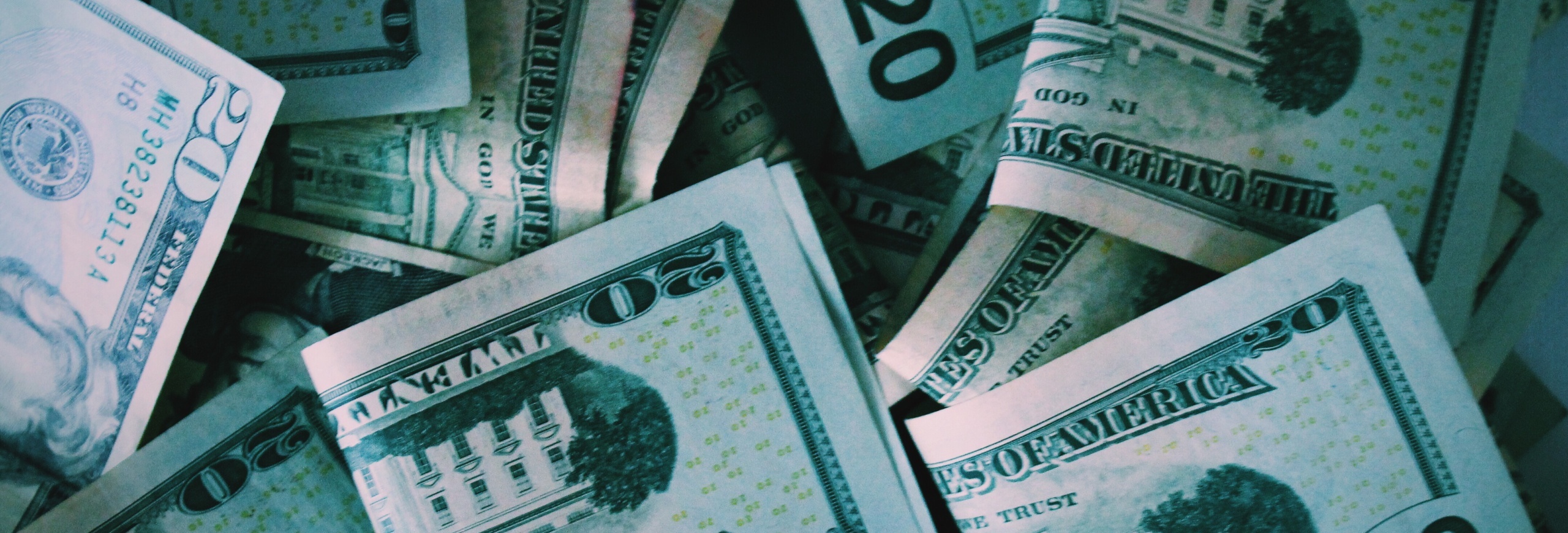
Run Me My Money: How to Get A Bank Loan
Since 2020, major banks have pledged to make capital and resources more accessible to Black and other underserved communities. For non-white entreprenuers, this may be a good time to borrow. But, there’s some work to be done.
Bad or no credit, lack of collateral and financial documents, weak cash flow and small risky loans are some of the reasons why Black and Brown business owners get denied on their loan applications, said Dr. Wayne W. Williams, Assistant Professor of Accounting at Temple University. For small business entrepreneurs wondering how best to navigate resources out there, here are a few tips:
Pre planning:
Many businesses get rejected because applicants show up without doing the homework. “Plan your journey,” Williams said. Loan applications require written business plans, financial statements or industry projections, applicable permits, licenses and legal documents, personal and business credit reports, tax returns and bank statements. Here’s a link on how to write a business plan.
Education:
“A good idea is not necessarily a viable business opportunity,” Williams said. Education is key to developing a strategy to sustain and grow a business. Find a Small Business Development Center (SBDC) that will train you to create a business plan, gather necessary documents and manage accounts. Here is a national directory of SBDC. The SBDCs provide free business consulting and at cost or free technical training. Connect with your local banker or Community Development Funding Institutions (CDFI).
Develop a personal relationship with the local bank or the CDFI in your area. If they know you and your story, you may bank some extra support on your application. Here is a national directory of CDFI’s and a link to local banks that invest in your community.
What’s the money for?
Be specific about how you want to use the finances. If a bank is loaning you money they want to know that you understand why you need the credit and how you plan to use it. Be realistic with your loan amount. If you ask for more than you can repay, you will be either denied or offered a lower amount.
Clean up credit history
Lenders scan personal and business credit reports while processing an application. They check payment history with existing and past creditors, and also take stock of current debt. Hard credit inquiries or interest only mortgages can affect a credit decision. Here’s how you access your business credit report. You can also check your personal credit score. If you have existing credit, pay it down. If you are prone to forgetting payment due dates, set up automatic payment. Dispute any unknown charges on your credit file. Government backed SBA loans or small business loans offered by traditional banks require excellent personal and business credit scores.
Gather collateral
Many lenders require applicants to use another asset such as a home, car or inventory to approve a loan, so that they can recover their money in case the applicant fails to make payments.
Cash flow and finances
A cash flow statement shows how much cash is coming in and going out of a business over a specified period of time. It’s important to document revenue and cash flow. Lenders often rely on those numbers to determine whether an applicant can incur additional debt.
Financial plan
Anything in the application that shows industry experience is helpful. Bankers like to see a financial plan with current profit and loss statements and future projections and expectations for the company and the industry.
Checking for accuracy
Make sure your application is complete and free of errors. A sloppy application never gets too far. Here are a few important details to document correctly in the application packet: name, location of the business and date it was established, ownership information, annual sales and income statements, tax returns, permits and regulations.
This story is part of a series called The Future of Work, which explores what work will look like as we move beyond the pandemic. It’s produced with funding from the William Penn Foundation and the Lenfest Institute for Journalism. WURD/Lively-Hood is one of more than 20 news organizations producing Broke in Philly, a collaborative reporting project on solutions to poverty and the city’s push towards economic mobility.



